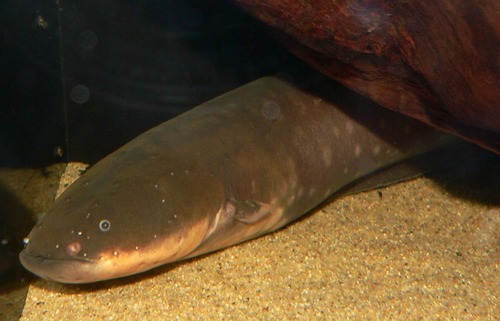
Electric Eel
The Atlantic bluefin tuna (Thunnus thynnus) is a highly migratory, large pelagic fish renowned for its size, speed, and commercial value. It's a top predator in the marine ecosystem, playing a crucial role in maintaining balance. This species faces significant conservation challenges due to its high demand.
15 25 years
Lifespan
200 - 240 cm
Length
Least Concern
Conservation Status
8 km/h
Swimming speed
Carnivorous
Diet
Local Migration
Migration
Appearance Overview
The Atlantic bluefin tuna is a large, streamlined fish with a metallic blue body and a silvery underside.
Color
Dark metallic blue on top with a silvery underside
Body Shape
Torpedo-shaped, built for speed and endurance
Fins
Two dorsal fins, the first is yellow or blueish, the second is reddish-brown
Length
Up to 13 feet (4 meters), commonly around 6.5 feet (2 meters)
Weight
Up to 1,500 lbs (680 kg), commonly around 550 lbs (250 kg)
Diet
Carnivorous, feeding on a variety of fish (such as mackerel, herring, and hake), squid, and crustaceans.
Feeding Behavior
Highly active predator that uses its speed and agility to hunt. They are opportunistic feeders, often hunting cooperatively in schools.
Social Behavior
Highly migratory, forming large schools, especially during spawning season. They exhibit complex social behaviors.
Commercial Relevance
Extremely high value, especially in sushi and sashimi markets, where a single fish can sell for thousands or even millions of dollars.
Conservation measures
International fishing quotas, seasonal closures, minimum size limits, and efforts to reduce bycatch. Some organizations promote sustainable aquaculture.
Status
Endangered (Varies by population segment; some are considered critically endangered)
Threats
Overfishing (historically and currently the primary threat), bycatch in other fisheries, habitat degradation, and climate change affecting prey distribution.
Habitat Distribution
Depth Range
0-980 meters (0-3,200 feet), typically in the upper layers of the water column.
Geographic Range
North Atlantic Ocean, Mediterranean Sea, and formerly the Black Sea.
Preferred Environment
Pelagic, open ocean, and coastal waters; prefers temperate waters.
Reproduction and Life Cycle
Breeding Habits
Spawns in warm waters, primarily in the Mediterranean Sea and the Gulf of Mexico. Spawning occurs in large aggregations.
Development Stages
Eggs hatch into larvae, which are planktonic. Juveniles grow rapidly, undergoing significant physiological changes as they mature.
Fecundity
Females are highly fecund, capable of producing up to 30 million eggs per spawning season.
Maturity Age
Maturity age varies by location; Mediterranean populations mature around 4-5 years, while western Atlantic populations mature later, around 8-12 years.
Faqs about Electric Eel
Where are Atlantic bluefin tuna found?
Atlantic bluefin tuna are found in the Atlantic Ocean, from the Mediterranean Sea to the Gulf of Mexico, and from Newfoundland to Brazil.
How long do Atlantic bluefin tuna live?
Atlantic bluefin tuna can live up to 40 years, although this is rare due to fishing pressure.
Can I eat Atlantic bluefin tuna?
Yes, but it's crucial to choose bluefin tuna from sustainably managed sources, which are currently very limited.
What do Atlantic Bluefin Tuna eat?
Atlantic bluefin tuna are apex predators, feeding on smaller fish, squid, and crustaceans.
How many eggs do they lay?
Females can release millions of eggs during spawning season.
How fast can Atlantic bluefin tuna swim?
They are among the fastest fish in the ocean, capable of bursts of speed up to 43 mph (70 km/h).
Copyright @ Nature Style Limited. All Rights Reserved.
 English
English